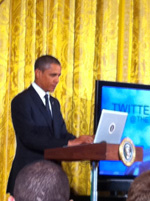Voting for a Face, Not a Candidate

Amidst the growing momentum of the election season, I catch myself thinking, with a worried look on my face: at the end of the day, what does a voting decision actually come down to? The reason for my worry is simple. I’ve spent a little too much time with the research of Princeton’s Alexander Todorov.
Since 2005, Todorov has conducted a number of studies, spanning numerous elections all over the world, and has come to a disconcerting conclusion: in many instances, we can be influenced in our vote by nothing more than the brief flash of a candidate’s face.
How competent a face appears predicts actual voting
In the original experiment, participants were presented with pairs of black and white photographs—the winners and runner-ups of House or Senate races in the 2000, 2002, and 2004 elections. For each pair, they were asked to state which of the two was the more competent. If a participant recognized a candidate, the data would be discarded.
The results were striking. After looking at the faces for as little as one second, individuals could produce competence ratings that were approximately 70% predictive of actual race outcomes. In other words, the judgment of a moment mirrored the results of an entire election. And as the Todorov team soon found, this was anything but a fluke.
A set of follow-up experiments found the effect to hold for gubernatorial elections. Even when the exposure time to the faces was lowered to 100 milliseconds, predictions still held strong at the 70% mark. In fact, when people were asked to deliberate and to do their very best to make a good judgment, their predictive accuracy declined: the more they thought, the less they could capture that elusive quality, that appearance of competence that worked its magic on voters as a whole. And the findings have been replicated in countries that include Finland, Mexico, Germany, and Australia.
I don’t know about you, but I find the results rather frightening. To me, it means that we are capable of making the weightiest of decisions on the basis of nothing more than a face. We may think we are taking other elements into account, but what we think and what is true are two very different things—one of the most often replicated findings of social psychology is how horrible we are at knowing why we do what we do and why we think as we think.
When our eyes trip us up
From an evolutionary perspective, our quickness to judge faces certainly makes sense. We need to know if someone is friend or foe, if he is strong or weak, if we can trust him or not. And we need to know quickly, before something bad happens. But is that quickness still as good when it determines national political outcomes?
In his new book Thinking, Fast and Slow, Daniel Kahneman writes about the way in which a sense of cognitive ease makes us feel good about our own judgment. If something comes to mind easily, we are more likely than not to trust it, to think of it as solid advice. A hardwired judgment of faces is easy. And the fluency with which our brains make a determination of competence from the structure of a jaw may lull us into thinking we know much more about someone—and much more about what kind of a leader that someone would make—than is in fact the case.
Now, if the judgment were actually a valid one—in other words, if people with strong jaws and just the right hint of a smile really were more competent and better political leaders—we’d be in business. But the evidence for that is scant. Just think of President Harding. A squarer jaw could not exist. And the presidency? Could have been better, to put it mildly.
So what to do? Honestly, I’m not sure. These types of biases are extraordinarily difficult to fight—especially so when we are bombarded with pictures and videos of candidates as often and early as we are. But at the very least, we can stop to take a second look. Or better yet: a second read or a second listen. I’d suggest doing your best to cover your eyes and open your ears, so that you let the words and not the images guide your thinking. Or, do some independent reading, minus the looking—those handy “print” buttons on articles these days usually omit all photographs, so why not read in a print-only format? That’s what I’ll be doing when election season really heats up.
If you’d like to receive information on new posts and other updates, follow Maria on Twitter @mkonnikova
[Photo credit: Joseph Stalin, from openDemocracy Flickr photostream. How’s that for a strong jaw and competent not-quite-smile?]





